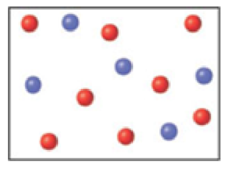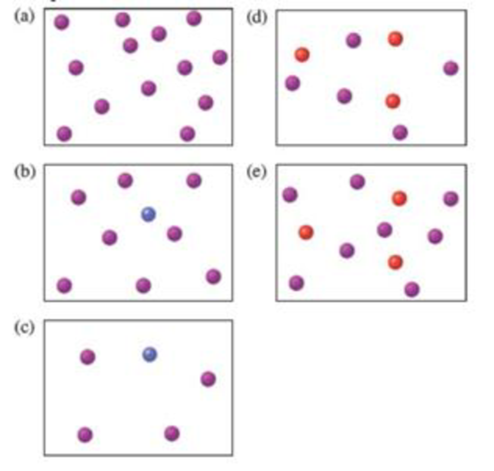
Chemistry: Atoms First
3rd Edition
ISBN: 9781259638138
Author: Julia Burdge, Jason Overby Professor
Publisher: McGraw-Hill Education
expand_more
expand_more
format_list_bulleted
Concept explainers
Textbook Question
Chapter 8, Problem 8.46QP
Reactants A (red) and B (blue) combine in the reaction vessel shown to form a single product C (purple) according to the equation 2A + B → C.

Which of the following scenes represents the contents of the reaction vessel after the reaction is complete?

Expert Solution & Answer
Want to see the full answer?
Check out a sample textbook solution
Students have asked these similar questions
Solve the spectro
Don't used hand raiting and don't used Ai solution
Don't used hand raiting and don't used Ai solution
Chapter 8 Solutions
Chemistry: Atoms First
Ch. 8.1 - Write and balance the chemical equation for the...Ch. 8.1 - Write and balance the chemical equation that...Ch. 8.1 - Prob. 1PPBCh. 8.1 - Prob. 1PPCCh. 8.1 - Butyric acid (also known as butanoic acid,...Ch. 8.1 - Another compound found in milk fat that appears to...Ch. 8.1 - Prob. 2PPBCh. 8.1 - Prob. 2PPCCh. 8.1 - Prob. 8.3WECh. 8.1 - Prob. 3PPA
Ch. 8.1 - Using the chemical species A2, B, and AB, write a...Ch. 8.1 - Prob. 3PPCCh. 8.1 - Prob. 8.1.1SRCh. 8.1 - Prob. 8.1.2SRCh. 8.1 - Prob. 8.1.3SRCh. 8.1 - Prob. 8.1.4SRCh. 8.1 - Prob. 8.1.5SRCh. 8.2 - Combustion of a 5.50-g sample of benzene produces...Ch. 8.2 - The combustion of a 28.1-g sample of ascorbic acid...Ch. 8.2 - Prob. 4PPBCh. 8.2 - Prob. 4PPCCh. 8.2 - Prob. 8.2.1SRCh. 8.2 - Prob. 8.2.2SRCh. 8.2 - Prob. 8.2.3SRCh. 8.3 - Prob. 8.5WECh. 8.3 - Nitrogen and hydrogen react to form ammonia...Ch. 8.3 - Prob. 5PPBCh. 8.3 - Prob. 5PPCCh. 8.3 - Prob. 8.6WECh. 8.3 - Calculate the mass of water produced by the...Ch. 8.3 - Prob. 6PPBCh. 8.3 - The models here represent the reaction of nitrogen...Ch. 8.3 - Prob. 8.3.1SRCh. 8.3 - What mass of lithium nitride is produced when 75.0...Ch. 8.3 - Prob. 8.3.3SRCh. 8.3 - Determine the stoichiometric amount (in grams) of...Ch. 8.4 - Alka-Seltzer tablets contain aspirin, sodium...Ch. 8.4 - Ammonia is produced by the reaction of nitrogen...Ch. 8.4 - Prob. 7PPBCh. 8.4 - The diagrams show a reaction mixture before and...Ch. 8.4 - Aspirin, acetylsalicylic acid (C9H8O4), is the...Ch. 8.4 - Diethyl ether is produced from ethanol according...Ch. 8.4 - What mass of ether will be produced if 207 g of...Ch. 8.4 - The diagrams show a mixture of reactants and the...Ch. 8.4 - How many moles of NH3 can be produced by the...Ch. 8.4 - Prob. 8.4.2SRCh. 8.4 - What is the percent yield for a process in which...Ch. 8.4 - Prob. 8.4.4SRCh. 8.4 - Reactants A (red) and B (blue) combine to form a...Ch. 8 - Calculate the mass of water produced in the...Ch. 8 - Calcium phosphide (Ca3P2) and water react to form...Ch. 8 - Prob. 8.3KSPCh. 8 - Prob. 8.4KSPCh. 8 - Prob. 8.1QPCh. 8 - Prob. 8.2QPCh. 8 - Why must a chemical equation he balanced? What law...Ch. 8 - Write an unbalanced equation to represent each of...Ch. 8 - Prob. 8.5QPCh. 8 - Prob. 8.6QPCh. 8 - For each of the following unbalanced chemical...Ch. 8 - Prob. 8.8QPCh. 8 - Balance the following equations using the method...Ch. 8 - Which of the following equations best represents...Ch. 8 - Prob. 8.11QPCh. 8 - Determine whether each of the following equations...Ch. 8 - Prob. 8.13QPCh. 8 - Prob. 8.14QPCh. 8 - Prob. 8.15QPCh. 8 - Prob. 8.16QPCh. 8 - Prob. 8.17QPCh. 8 - Prob. 8.18QPCh. 8 - Prob. 8.19QPCh. 8 - Prob. 8.20QPCh. 8 - Prob. 8.21QPCh. 8 - Prob. 8.22QPCh. 8 - Prob. 8.23QPCh. 8 - On what law is stoichiometry based? Why is it...Ch. 8 - Prob. 8.25QPCh. 8 - Prob. 8.26QPCh. 8 - Prob. 8.27QPCh. 8 - Prob. 8.28QPCh. 8 - Prob. 8.29QPCh. 8 - Prob. 8.30QPCh. 8 - Prob. 8.31QPCh. 8 - Prob. 8.32QPCh. 8 - Prob. 8.33QPCh. 8 - When copper(II) sulfate pentahydrate (CuSO4 5H2O)...Ch. 8 - For many years, the extraction of gold from other...Ch. 8 - Prob. 8.36QPCh. 8 - Nitrous oxide (N2O) is also called laughing gas....Ch. 8 - Prob. 8.38QPCh. 8 - Prob. 8.39QPCh. 8 - Prob. 8.1VCCh. 8 - Prob. 8.2VCCh. 8 - Prob. 8.3VCCh. 8 - Prob. 8.4VCCh. 8 - Prob. 8.40QPCh. 8 - Prob. 8.41QPCh. 8 - Why is the theoretical yield of a reaction...Ch. 8 - Why is the actual yield of a reaction almost...Ch. 8 - Prob. 8.44QPCh. 8 - Prob. 8.45QPCh. 8 - Reactants A (red) and B (blue) combine in the...Ch. 8 - Prob. 8.47QPCh. 8 - Prob. 8.48QPCh. 8 - Prob. 8.49QPCh. 8 - Propane (C3H8) is a minor component of natural gas...Ch. 8 - Prob. 8.51QPCh. 8 - Prob. 8.52QPCh. 8 - Prob. 8.53QPCh. 8 - Prob. 8.54QPCh. 8 - Prob. 8.55QPCh. 8 - Prob. 8.56QPCh. 8 - Disulfur dichloride (S2Cl2) is used in the...Ch. 8 - Prob. 8.58QPCh. 8 - Prob. 8.59QPCh. 8 - Prob. 8.60QPCh. 8 - Prob. 8.61QPCh. 8 - Prob. 8.62QPCh. 8 - Prob. 8.63QPCh. 8 - Prob. 8.64QPCh. 8 - Prob. 8.65QPCh. 8 - Industrially, nitric acid is produced by the...Ch. 8 - Prob. 8.67QPCh. 8 - Prob. 8.68QPCh. 8 - Prob. 8.69QPCh. 8 - Prob. 8.70QPCh. 8 - Prob. 8.71QPCh. 8 - Prob. 8.72QPCh. 8 - Prob. 8.73QPCh. 8 - Prob. 8.74QPCh. 8 - Prob. 8.75QPCh. 8 - Prob. 8.76QPCh. 8 - Prob. 8.77QPCh. 8 - Prob. 8.78QPCh. 8 - Prob. 8.79QPCh. 8 - The combustion of a 5.50-g sample of oxalic acid...Ch. 8 - Prob. 8.81QPCh. 8 - Prob. 8.82QPCh. 8 - Prob. 8.83QPCh. 8 - Prob. 8.84QPCh. 8 - Prob. 8.85QPCh. 8 - Prob. 8.86QPCh. 8 - Potash is any potassium mineral that is used for...Ch. 8 - A 21.496-g sample of magnesium is burned in air to...Ch. 8 - Prob. 8.89QPCh. 8 - Prob. 8.90QPCh. 8 - Prob. 8.91QPCh. 8 - Prob. 8.92QPCh. 8 - Prob. 8.93QPCh. 8 - Prob. 8.94QPCh. 8 - Prob. 8.95QPCh. 8 - Prob. 8.96QPCh. 8 - Prob. 8.97QPCh. 8 - Prob. 8.98QPCh. 8 - A compound X contains 63.3 percent manganese (Mn)...
Knowledge Booster
Learn more about
Need a deep-dive on the concept behind this application? Look no further. Learn more about this topic, chemistry and related others by exploring similar questions and additional content below.Similar questions
- 2. 200 LOD For an unknown compound with a molecular ion of 101 m/z: a. Use the molecular ion to propose at least two molecular formulas. (show your work) b. What is the DU for each of your possible formulas? (show your work) C. Solve the structure and assign each of the following spectra. 8 6 4 2 (ppm) 150 100 50 ō (ppm) 4000 3000 2000 1500 1000 500 HAVENUMBERI-11arrow_forwardComplete the spectroscopy with structurearrow_forwardComplete the spectroscopy with structurearrow_forward
- Given the following concentrations for a system, calculate the value for the reaction quotient: Cl2(g)+ CS2(g) ⇌ CCl4(g)+ S2Cl2(g) Cl2 = 31.1 atm CS2 = 91.2 atm CCl4 = 2.12 atm S2Cl2 = 10.4 atmarrow_forwardMatch each chemical or item with the proper disposal or cleanup mwthod, Not all disposal and cleanup methods will be labeled. Metal sheets C, calcium, choroide solutions part A, damp metal pieces Part B, volumetric flask part A. a.Return to correct lables”drying out breaker. Place used items in the drawer.: Rinse with deionized water, dry as best you can, return to instructor. Return used material to the instructor.: Pour down the sink with planty of running water.: f.Pour into aqueous waste container. g.Places used items in garbage.arrow_forwardWrite the equilibrium constant expression for the following reaction: HNO2(aq) + H2O(l) ⇌ H3O+(aq) + NO2-(aq)arrow_forward
arrow_back_ios
SEE MORE QUESTIONS
arrow_forward_ios
Recommended textbooks for you
 Chemistry: The Molecular ScienceChemistryISBN:9781285199047Author:John W. Moore, Conrad L. StanitskiPublisher:Cengage Learning
Chemistry: The Molecular ScienceChemistryISBN:9781285199047Author:John W. Moore, Conrad L. StanitskiPublisher:Cengage Learning Chemistry for Engineering StudentsChemistryISBN:9781337398909Author:Lawrence S. Brown, Tom HolmePublisher:Cengage Learning
Chemistry for Engineering StudentsChemistryISBN:9781337398909Author:Lawrence S. Brown, Tom HolmePublisher:Cengage Learning Chemistry & Chemical ReactivityChemistryISBN:9781133949640Author:John C. Kotz, Paul M. Treichel, John Townsend, David TreichelPublisher:Cengage Learning
Chemistry & Chemical ReactivityChemistryISBN:9781133949640Author:John C. Kotz, Paul M. Treichel, John Townsend, David TreichelPublisher:Cengage Learning Introduction to General, Organic and BiochemistryChemistryISBN:9781285869759Author:Frederick A. Bettelheim, William H. Brown, Mary K. Campbell, Shawn O. Farrell, Omar TorresPublisher:Cengage Learning
Introduction to General, Organic and BiochemistryChemistryISBN:9781285869759Author:Frederick A. Bettelheim, William H. Brown, Mary K. Campbell, Shawn O. Farrell, Omar TorresPublisher:Cengage Learning Chemistry: Principles and PracticeChemistryISBN:9780534420123Author:Daniel L. Reger, Scott R. Goode, David W. Ball, Edward MercerPublisher:Cengage Learning
Chemistry: Principles and PracticeChemistryISBN:9780534420123Author:Daniel L. Reger, Scott R. Goode, David W. Ball, Edward MercerPublisher:Cengage Learning General Chemistry - Standalone book (MindTap Cour...ChemistryISBN:9781305580343Author:Steven D. Gammon, Ebbing, Darrell Ebbing, Steven D., Darrell; Gammon, Darrell Ebbing; Steven D. Gammon, Darrell D.; Gammon, Ebbing; Steven D. Gammon; DarrellPublisher:Cengage Learning
General Chemistry - Standalone book (MindTap Cour...ChemistryISBN:9781305580343Author:Steven D. Gammon, Ebbing, Darrell Ebbing, Steven D., Darrell; Gammon, Darrell Ebbing; Steven D. Gammon, Darrell D.; Gammon, Ebbing; Steven D. Gammon; DarrellPublisher:Cengage Learning

Chemistry: The Molecular Science
Chemistry
ISBN:9781285199047
Author:John W. Moore, Conrad L. Stanitski
Publisher:Cengage Learning

Chemistry for Engineering Students
Chemistry
ISBN:9781337398909
Author:Lawrence S. Brown, Tom Holme
Publisher:Cengage Learning

Chemistry & Chemical Reactivity
Chemistry
ISBN:9781133949640
Author:John C. Kotz, Paul M. Treichel, John Townsend, David Treichel
Publisher:Cengage Learning

Introduction to General, Organic and Biochemistry
Chemistry
ISBN:9781285869759
Author:Frederick A. Bettelheim, William H. Brown, Mary K. Campbell, Shawn O. Farrell, Omar Torres
Publisher:Cengage Learning

Chemistry: Principles and Practice
Chemistry
ISBN:9780534420123
Author:Daniel L. Reger, Scott R. Goode, David W. Ball, Edward Mercer
Publisher:Cengage Learning

General Chemistry - Standalone book (MindTap Cour...
Chemistry
ISBN:9781305580343
Author:Steven D. Gammon, Ebbing, Darrell Ebbing, Steven D., Darrell; Gammon, Darrell Ebbing; Steven D. Gammon, Darrell D.; Gammon, Ebbing; Steven D. Gammon; Darrell
Publisher:Cengage Learning
Bonding (Ionic, Covalent & Metallic) - GCSE Chemistry; Author: Science Shorts;https://www.youtube.com/watch?v=p9MA6Od-zBA;License: Standard YouTube License, CC-BY
Stoichiometry - Chemistry for Massive Creatures: Crash Course Chemistry #6; Author: Crash Course;https://www.youtube.com/watch?v=UL1jmJaUkaQ;License: Standard YouTube License, CC-BY